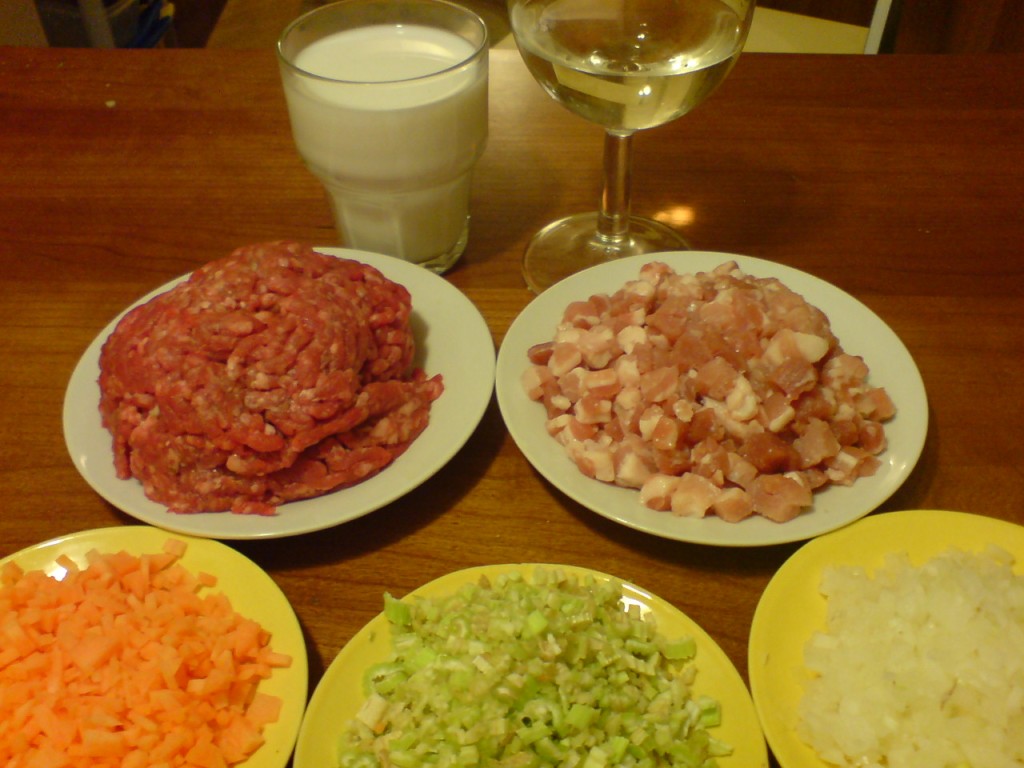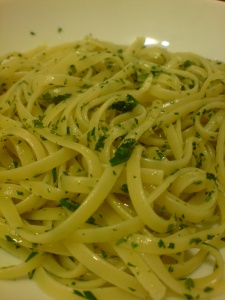 In truth there probably isn’t one authentic recipe for Ragu alla Bolognese, but this one is close enough. There are however countless inauthentic ones. It bears little or no resemblance to the dish known as Bolognese or Bolognaise found outside of Italy. It is also never served with Spaghetti!
In truth there probably isn’t one authentic recipe for Ragu alla Bolognese, but this one is close enough. There are however countless inauthentic ones. It bears little or no resemblance to the dish known as Bolognese or Bolognaise found outside of Italy. It is also never served with Spaghetti!
On October 17, 1982, the Bolognese chapter of the Accademia Italiana della Cucina, “after having carried out long and laborious investigations and conducted studies and research”, announced the following recipe to be the official one. I’m sure that every family in Emilia Romagna has their own version though. Serves 4.

- 400 grams fresh tagliatelle or fettucine
- 300 grams minced beef – The recommended cut is thin flank aka skirt (finta cartella in Italian) but any good quality mince will do.
- 150 grams unsmoked pancetta — minced very finely
- 50 grams carrot — finely chopped or minced
- 50 grams celery — finely chopped or minced
- 50 grams onion — finely chopped or minced
- 30 grams triple concentrated tomato purée(if using double concentrated, increase the quantity by about a third, purée is known as “tomato paste” in the US)
- 1/2 glass red or white wine
- 180 ml fresh milk
- olive oil
- salt and pepper
- Fry the pancetta gently in a little olive oil until it starts to release its fat. Be careful not to burn.
- Add the vegetables and fry until the onions are transparent, stirring from time to time.
- Add the beef and cook until it is lightly browned. When it starts to make popping noises, it’s done.
- Add the tomato puree and the wine and mix well.
- Add the milk, little by little until it is completely absorbed.
- Season with salt and pepper, cover and cook very slowly for 3 to 4 hours.
- Stir occasionally and if it looks like drying out, add a little more milk.
- Serve with Fettuccine or Tagliatelle (NOT Spaghetti!)
- Serve with Parmesan cheese on the side. Alternatively toss the pasta first in a little butter and then in Parmesan before adding the meat sauce.
- Variation: The Academy allows the addition of Porcini mushrooms.

Bolognese finished dish
This is a more detailed explanation of the dish from Bologna Cooking School
A ragu Bolognese style is a meat sauce that is slow simmered for at least an hour to develop a complex flavor and proper thickness. Cooking the ragu in a heavy-duty enamel or similar pot will hold the heat steady and help to give a velvety texture to the ragu. Bolognese ragu is a classic sauce for lasagne and tagliatelle. The sauce also freezes beautifully.
Bolognese sauce (ragù alla bolognese in Italian) is a meat- and tomato-based pasta sauce originating in Bologna, Italy. It is typically made by simmering ground meat in tomato sauce, white wine, and stock for a long time (often upward of four hours), so that the meat softens and begins to break down into the liquid medium. The original sauce is not done with minced meat; instead, whole meat, usually beef or veal, is chopped with a knife.
Spaghetti alla Bolognese, or spaghetti bolognese which is sometimes further shortened to spag bol, is a dish invented outside of Italy consisting of spaghetti with a meat sauce. In Italy, this sauce is generally not served with spaghetti because it tends to fall off the pasta and stay on the plate. Instead, the people of Bologna traditionally serve their famous meat sauce with tagliatelle (‘tagliatelle alla bolognese). Outside the traditional use, this sauce can be served with tubular pasta or represent the stuffing for lasagna or cannelloni.
While “Bolognese” is undoubtedly the most popular ragù in this country, it is also the most misunderstood.
The ragù you get by that name is usually a characterless tomato sauce with pea-like bits of ground beef floating in it, bearing little resemblance to anything you’d find in Bologna.
And not, in any sense, a ragù.
True ragù alla Bolognese contains no tomato sauce — just enough fresh or canned tomato to add a hint of sweetness and another layer of flavor to a subtle, complex mix. Like all ragùs, Bolognese is characterized by its long, slow cooking, which in this case starts with simmering the meat in milk (to mellow the acidity of the raw tomatoes added later) and wine (some use white, others red), after which the tomatoes are added. The whole lot is cooked together for about two hours



 Coniglio alla Cacciatore or Huntsman’s Rabbit. When I lived in Bergamo the Sunday lunch was usually roast rabbit with polenta. I was regularly woken at seven in the morning by my neighbour grinding his polenta under my bedroom window. I’m sure he did it on purpose (we didn’t get on that well 😉 ) I see that rabbit is coming back into fashion in the UK, so I thought I’d share this recipe. It’s not roast rabbit, but another common Bergamasco dish. You can use any type of mushroom, even porcini if your bank balance will stand it. Serves 4
Coniglio alla Cacciatore or Huntsman’s Rabbit. When I lived in Bergamo the Sunday lunch was usually roast rabbit with polenta. I was regularly woken at seven in the morning by my neighbour grinding his polenta under my bedroom window. I’m sure he did it on purpose (we didn’t get on that well 😉 ) I see that rabbit is coming back into fashion in the UK, so I thought I’d share this recipe. It’s not roast rabbit, but another common Bergamasco dish. You can use any type of mushroom, even porcini if your bank balance will stand it. Serves 4




 From Lazio. What is Carbonara? If You ask an Englishman they’ll probably tell you it’s a dish prepared with cream and ham! Nooooooo!!!!! 😉 More crimes against Italian food have been committed under the name of Carbonara than any other dish.
From Lazio. What is Carbonara? If You ask an Englishman they’ll probably tell you it’s a dish prepared with cream and ham! Nooooooo!!!!! 😉 More crimes against Italian food have been committed under the name of Carbonara than any other dish.















 In truth there probably isn’t one authentic recipe for Ragu alla Bolognese, but this one is close enough. There are however countless inauthentic ones. It bears little or no resemblance to the dish known as Bolognese or Bolognaise found outside of Italy. It is also never served with Spaghetti!
In truth there probably isn’t one authentic recipe for Ragu alla Bolognese, but this one is close enough. There are however countless inauthentic ones. It bears little or no resemblance to the dish known as Bolognese or Bolognaise found outside of Italy. It is also never served with Spaghetti!



 Carpaccio Di Carne. The original version of this dish comes from Venice. According to Arrigo Cipriani, the present-day owner, Carpaccio was invented at Harry’s Bar in Venice, where it was first served to the countess Amalia Nani Mocenigo in 1950 when she informed the bar’s owner that her doctor had recommended she eat only raw meat. It consisted of thin slices of raw beef dressed with a mustard and mayonnaise sauce. The dish was named Carpaccio by Giuseppe Cipriani, the bar’s former owner, in reference to the Venetian painter Vittore Carpaccio, because the colours of the dish reminded him of paintings by Carpaccio.This lighter version is far more common nowadays.
Carpaccio Di Carne. The original version of this dish comes from Venice. According to Arrigo Cipriani, the present-day owner, Carpaccio was invented at Harry’s Bar in Venice, where it was first served to the countess Amalia Nani Mocenigo in 1950 when she informed the bar’s owner that her doctor had recommended she eat only raw meat. It consisted of thin slices of raw beef dressed with a mustard and mayonnaise sauce. The dish was named Carpaccio by Giuseppe Cipriani, the bar’s former owner, in reference to the Venetian painter Vittore Carpaccio, because the colours of the dish reminded him of paintings by Carpaccio.This lighter version is far more common nowadays.


